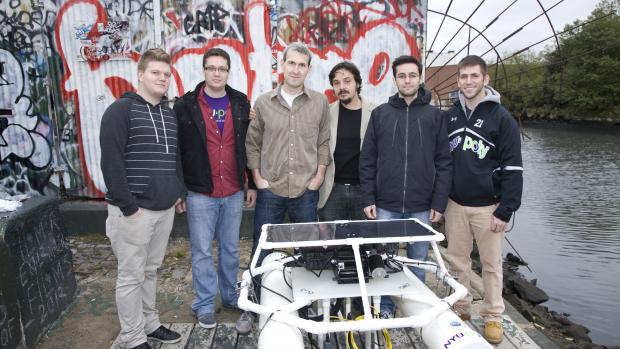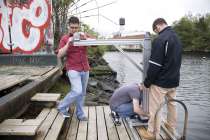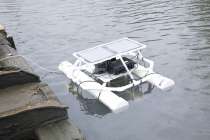Brooklyn Atlantis: A Robot Captures Life, Litter in the Gowanus With the Help of Citizen Scientists

As Maurizio Porfiri and Oded Nov lowered their submersible robot, Brooklyn Atlantis 1, into the water, the two professors and their four students, Jarred Humphrey, Vladislav Kopman, Jeffrey Laut, and William Quigley, held their breaths. It wasn’t because they were nervous, although their project is the first of its kind in Brooklyn and their hopes are high; they were on the banks of the Gowanus Canal, the infamously polluted waterway and designated Superfund site that cuts a foul-smelling swath through some of the borough’s nicest neighborhoods. Professor Porfiri, who designed the aquatic vehicle with the assistance of his students Emiliano Henry and Jeffrey Laut, in the Polytechnic Institute of New York University’s (NYU-Poly) Dynamical Systems Lab, half-joked, “please, nobody fall in.”
 For Porfiri, associate professor of mechanical engineering and Nov, assistant professor of technology management, Brooklyn Atlantis is the ultimate opportunity to combine their research passions—underwater robotics and technology-mediated social participation—and give back to the community at the same time.
For Porfiri, associate professor of mechanical engineering and Nov, assistant professor of technology management, Brooklyn Atlantis is the ultimate opportunity to combine their research passions—underwater robotics and technology-mediated social participation—and give back to the community at the same time.
Brooklyn Atlantis is a custom-built, remote-controlled, mobile robotic vessel that will monitor the underwater environment in the Gowanus Canal. Equipped with two cameras—one at the water’s surface and one below—as well as sensors to check water temperature, conductivity, pH and oxygen levels, the 60-pound vehicle has onboard broadband service to transmit real-time findings to the project’s website every 30 seconds.
Analyzing even a fraction of the more than 20,000 images Brooklyn Atlantis will snap each week would be impossible without hundreds of extra pairs of eyes.
 “This is where citizen scientists come into play,” says Nov, describing the increasing reliance of researchers on the help of the public, untrained in science but interested in participating in scientific discovery. “We’re relying on volunteer citizen scientists to get involved, access the website, and start tagging pictures,” said Nov. “It takes no formal training to identify objects in a photo, whether it’s a plant, a fish or an unidentified sharp object, but this information is essential to helping us identify patterns and monitor progress as the Canal is cleaned.”
“This is where citizen scientists come into play,” says Nov, describing the increasing reliance of researchers on the help of the public, untrained in science but interested in participating in scientific discovery. “We’re relying on volunteer citizen scientists to get involved, access the website, and start tagging pictures,” said Nov. “It takes no formal training to identify objects in a photo, whether it’s a plant, a fish or an unidentified sharp object, but this information is essential to helping us identify patterns and monitor progress as the Canal is cleaned.”
Over time, the researchers hope to construct a history of changing conditions in the Gowanus as the cleanup progresses. This includes tracking the appearance or disappearance of wildlife, amounts and types of litter and debris and changes in water quality. Porfiri and Nov plan to make their data and analyses available to the Environmental Protection Agency.
Porfiri, who has worked extensively with New York City public schools to increase students’ interest in robotics, acknowledges that Brooklyn Atlantis is relying not just on adults, but on local students to get involved. “This is an amazing opportunity to get young people interested in science,” he said. “It’s a chance for classrooms to learn about marine biology and environmental science using data that is literally in their backyards,” he added.
 Brooklyn Atlantis launches this week. In the coming weeks, the robot will begin ongoing data collection. By 2014, Porfiri and Nov expect to add three more vehicles to the fleet, along with video streaming capabilities and additional sensors for salinity and air quality.
Brooklyn Atlantis launches this week. In the coming weeks, the robot will begin ongoing data collection. By 2014, Porfiri and Nov expect to add three more vehicles to the fleet, along with video streaming capabilities and additional sensors for salinity and air quality.
Brooklyn Atlantis is funded by a three-year, $560,000 grant from the National Science Foundation through its Cyber-Enabled Discovery and Innovation program.
Porfiri and Nov envision Brooklyn Atlantis as a prototype for a system that may assist in future marine disasters. “Imagine a vehicle like this being deployed at the site of an oil or chemical spill,” said Porfiri. “It’s a low-cost system that can offer a lot of benefits, especially if it’s designed for public participation.”
“This a perfect test bed for learning how to make distributed citizen science projects as engagingand effective as possible,” said Nov. “we’re developing a cyber-human infrastructure for real time environmental monitoring and it’s all in our back yard.”




